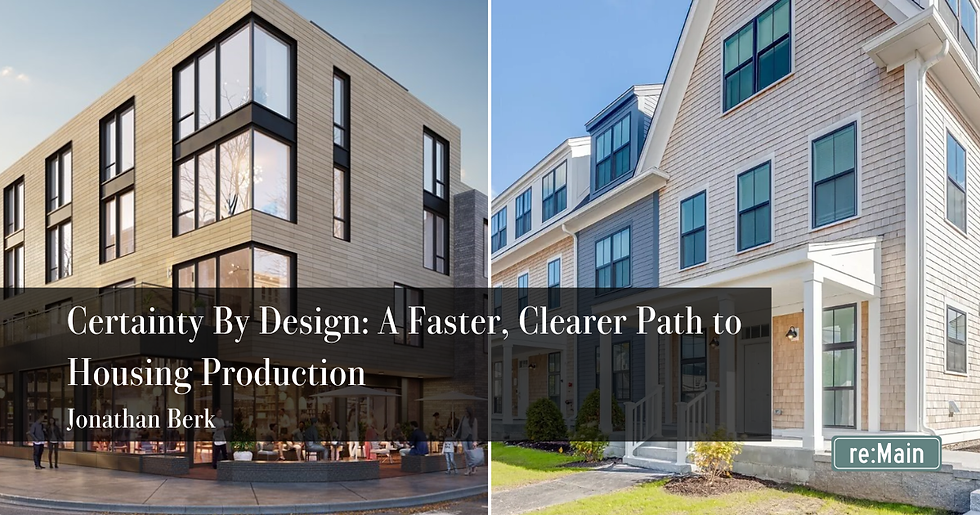Small Developers Are Key to Building More Homes, But They Need Help
- Jonathan Berk

- May 6, 2024
- 4 min read
Financing Innovations Will Help Everyone Create Great Neighborhoods
Jonathan Berk | Special to Banker & Tradesman | May 6th, 2024

Massachusetts has the opportunity to produce the housing we need, at a scale not seen since the 1950s. We can provide the stable housing our growing regional economy needs and make our communities stronger, happier, more resilient, more diverse places to live while building local wealth in the process. How? By unlocking a new generation of infill developers supported by a broader systems changes that make it easier to permit and finance housing.
This will require us to move beyond implementing zoning reforms like MBTA Communities. Today, it’s more difficult than ever for smaller developers to produce housing due to restrictive local zoning, risky, lengthy permitting and entitlements processes and unfavorable capital markets that are less enticed to finance smaller developments with smaller returns.
While we certainly need large, institutional developers to help build our way out of a housing supply crisis, in many of our cities and towns “missing middle” housing developers are just as, if not more of a critical piece of the puzzle. We need to ensure we’re not only producing housing today, but that our region is well positioned to continue to produce the housing we need for decades to come.
Financing Innovations Needed
Smaller developers tend to work in their backyards, driven by a desire to both invest in housing while building great places. However, traditional real estate development capital markets are ill-equipped to support what’s often viewed as riskier, smaller real estate investments at any kind of scale.
While private lenders or “friends and family money” may be an option for some, it precludes the vast majority of smaller prospective developers who may not have deep pockets in their networks. The situation commands outside-the-box thinking and new models of financing from new sources of capital that can be put to work in our communities.
Nonprofit and philanthropic communities could consider loan programs to seed small developers, creating a type of “venture fund” for small infill developers. Working with area employers who worry about their employees’ ability to obtain housing in the area to create local investment funds would allowing these businesses to invest directly in the communities where their employees reside, with the flexibility to embrace slightly lower short-term returns than traditional capital sources.
On the public side, MassHousing and the Massachusetts Housing Investment Corp. recently announced a new $50 million Equitable Developers Fund aimed directly at local small developers from “economically disadvantaged backgrounds and communities.” With Black and Hispanic developers making up less than 1 percent of the industry, the solutions to today’s housing issues can and should also be viewed as our opportunity to build more diversity into the local development force.
Building Code Reforms Will Help
Major change can also be accomplished through an audit to identify necessary and unnecessary segments of our state’s building code.
Elements that were put in place 50-plus years ago may no longer be needed due to innovations in construction and life safety practices. For years, many North American cities have required buildings to provide two staircases which, especially for smaller buildings, means a lot of lost interior square footage that could be used for living space while boxing developers into certain types of buildings and unit sizes.
New building technologies, like modular construction, need to be more widely embraced, ensuring our state and local code enforcement agencies are prepared to adapt processes and procedures to enable them to produce housing as efficiently and affordably as the advancements in technology allow.
Permitting Reform Opens Doors
Many of the cost efficiencies realized by modular construction are in the ability for local zoning and permitting to have some consistency and uniformity across the state. This is largely not the case today and we’re unable to realize the true production cost savings of things like modular accessory dwelling units without uniformity in permitting statewide, something included in Gov. Maura Healey’s housing bond bill.
Reforming expensive, uncertain and lengthy municipal and state permitting processes also must be addressed. Despite progress on zoning reform, permitting and entitlement processes continue to present expensive and inconsistent barriers to housing production in many communities.
Building new housing is an incredibly risky proposition. Add in lengthy municipal reviews, uncertainty, surprise expenses, varying approval timelines and the threat of frivolous abutter lawsuits adding cost and time delays and you make new housing a bridge too far for many small developers.
To provide the sustainable, equitable housing we need in the types of communities we want to live in for the Massachusetts of 2030, as well as the Massachusetts of 2100, we have to think beyond the paradigms that have constrained our growth in the region for the bulk of the past 60 years. We can add hundreds of thousands of new units of housing, while not only preserving our region’s world-class quality of life but enhancing it by providing more affordability in our housing markets while enabling more members of our community to take part in building a more sustainable and equitable future commonwealth.
Jonathan Berk is the founder of re:Main, a new organization working with public and private sector partners to enhance our walkable neighborhoods, and a board member of Abundant Housing Massachusetts.



Comments